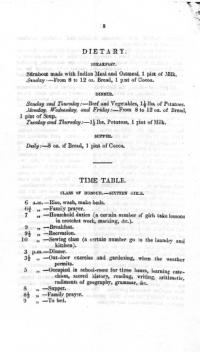Timetable
Published in 20th-century / Contemporary History, Features, General, Issue 2 (March/April 2013), Volume 21 The daily timetable for the reformatories usually included six hours of work and three of instruction. Some children were refused admission to the schools, especially the boys’ schools, if it was considered that they were too ill to work. The children themselves sometimes tried to subvert the system by feigning illness. The inspector of lunatic asylums was brought to High Park after ‘several cases of violent hysterical and epileptic seizures’ occurred. Such girls were transferred to Spark’s Lake, where some girls who had been pronounced incurable ‘recovered’. Other children arrived at the school with physical manifestations of their former lives. Mary Joyce, aged fourteen, had survived by ‘leading her blind mother who subsisted by begging’ until she was convicted for stealing a ham in 1880. She died of consumption in Spark’s Lake two years later. ‘C.M.’ arrived there in an advanced consumptive state. She had been working as a servant and, hearing that doctors in Dublin might be able to cure her, she obtained goods under false pretences in order to pay for her treatment. Although she was not given a reformatory sentence, the St Louis nuns heard that she was close to death in prison and asked that she be sent to them. Within less than a year she had recovered and had taken up a situation outside the reformatory.
The daily timetable for the reformatories usually included six hours of work and three of instruction. Some children were refused admission to the schools, especially the boys’ schools, if it was considered that they were too ill to work. The children themselves sometimes tried to subvert the system by feigning illness. The inspector of lunatic asylums was brought to High Park after ‘several cases of violent hysterical and epileptic seizures’ occurred. Such girls were transferred to Spark’s Lake, where some girls who had been pronounced incurable ‘recovered’. Other children arrived at the school with physical manifestations of their former lives. Mary Joyce, aged fourteen, had survived by ‘leading her blind mother who subsisted by begging’ until she was convicted for stealing a ham in 1880. She died of consumption in Spark’s Lake two years later. ‘C.M.’ arrived there in an advanced consumptive state. She had been working as a servant and, hearing that doctors in Dublin might be able to cure her, she obtained goods under false pretences in order to pay for her treatment. Although she was not given a reformatory sentence, the St Louis nuns heard that she was close to death in prison and asked that she be sent to them. Within less than a year she had recovered and had taken up a situation outside the reformatory.
















